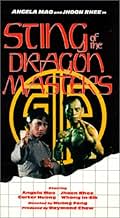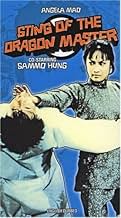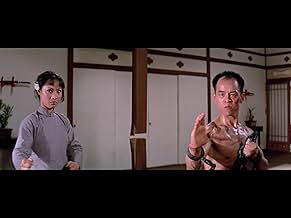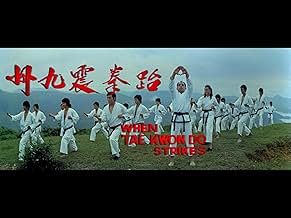NOTE IMDb
6,4/10
322
MA NOTE
Ajouter une intrigue dans votre langueDuring the Japanese occupation of Korea, the leader of a resistance movement, who's also a Taekwondo master, and his apprentices struggle against the brutal Japanese occupiers, aided by a Ch... Tout lireDuring the Japanese occupation of Korea, the leader of a resistance movement, who's also a Taekwondo master, and his apprentices struggle against the brutal Japanese occupiers, aided by a Chinese female martial artist.During the Japanese occupation of Korea, the leader of a resistance movement, who's also a Taekwondo master, and his apprentices struggle against the brutal Japanese occupiers, aided by a Chinese female martial artist.
- Réalisation
- Scénario
- Casting principal
Carter Wong
- Jin Zheng Zhi
- (as Carter Huang)
Avis à la une
Set in Korea, the film follows a small band of rebels who are engaged in fighting with occupying Japanese forces. Rhee stars as the leader of the resistance and, together with Chinese Hapkido expert Wan Ling-Ching (Mao), must ensure the safety of his group by seeking the help of their Chinese allies.
Angelo Mao whups some behind once again when helping a resistance leader and consequently running into some Japanese, who are the villains here, and they're painted as nasty individuals. It's a solid picture, has a strong story and some good emotions conveyed by Mao and Rhees. But it's the dazzling display of gritty "school of hard knock" action that beholds you. If you liked Hapkido, this would be up your street.
Angelo Mao whups some behind once again when helping a resistance leader and consequently running into some Japanese, who are the villains here, and they're painted as nasty individuals. It's a solid picture, has a strong story and some good emotions conveyed by Mao and Rhees. But it's the dazzling display of gritty "school of hard knock" action that beholds you. If you liked Hapkido, this would be up your street.
While the film is not abundant with taekwondo philosophy or technique, it does tell a story that most American taekwondo students are unfamiliar with. That story is set in the backdrop of the Japanese occupation of Korea during World War II and the Korean resistance to that occupation. This tale of modern oppression is, simultaneously, a tale of how embedded in the fabric of the Korean culture taekwondo is. Rhee plays the leader of the underground resistance who is, of course, a taekwondo Grandmaster. Rhee is forced to reveal his identity, and risk death, in order to attempt to save the life of an imprisoned Catholic Priest.
The film's sparse dialogue is subtitled but the action is plentiful as Rhee is joined by an All Star cast of Asian action stars, including Angela Mao, Carter Wong, Sammo Hung, and many more fighters/actors. While many styles of martial arts are evident, the presence of Rhee and Anne Winton, Rhee's star pupil off the movie screen, remind us that this is, theoretically, a taekwondo action film.
As a snapshot of modern Korean history and a look at the role of Taekwondo in personal defense and the defense of a culture I do recommend this film."
Two years later, in 2018 Grandmaster Rhee would pass away and be mourned all over the world for his contributions to Taekwondo and humanity.
One of the interesting and little know facts about this film was that it was Bruce Lee who introduced his friend, Jhoon Rhee, to Golden Harvest to get the film made. In addition to Lee's friendship with Rhee he liked the fact that the story of the film involved a similar theme to Lee's own Fist of Fury. That theme was resistance to Japanese occupying forces.
The film is also known and been released as Sting of the Dragon Masters and Taekwondo Heroes.
The film's sparse dialogue is subtitled but the action is plentiful as Rhee is joined by an All Star cast of Asian action stars, including Angela Mao, Carter Wong, Sammo Hung, and many more fighters/actors. While many styles of martial arts are evident, the presence of Rhee and Anne Winton, Rhee's star pupil off the movie screen, remind us that this is, theoretically, a taekwondo action film.
As a snapshot of modern Korean history and a look at the role of Taekwondo in personal defense and the defense of a culture I do recommend this film."
Two years later, in 2018 Grandmaster Rhee would pass away and be mourned all over the world for his contributions to Taekwondo and humanity.
One of the interesting and little know facts about this film was that it was Bruce Lee who introduced his friend, Jhoon Rhee, to Golden Harvest to get the film made. In addition to Lee's friendship with Rhee he liked the fact that the story of the film involved a similar theme to Lee's own Fist of Fury. That theme was resistance to Japanese occupying forces.
The film is also known and been released as Sting of the Dragon Masters and Taekwondo Heroes.
I won't waste your time by describing the plot for this, the other reviewer already did this quite well. I will however give you my opinion of this movie. This movie is basically anti japanese propoganda. The japanese are portrayed as incredably evil b**tards who have respect for nothing, as well as having very poor martial arts skills (groups of japanese men get there asses kicked by single women on more than one occasion.) The fact that the japanese fighters lose almost every (if not every) fight in the movie kind of takes away the suspense. The plot is actually quite solid and perfect for a kung fu movie though. The problem lies in the fact that there's not much fighting. When there are fights some of the fighting is quite good, but other scenes are choreographed badly. One scene angela mao takes on six japanese in a church and kicks all their asses. The problem is they show her fighting them one by one when they're all supposed to be attacking at the same time. I gather this movie was incredably cheap considering how cheap some of the sets are. They use the same village set for when they are in korea and when they are in china without changing it at all. Some scenes are filmed at real locations though, and they look good. Overall the only real problem with the movie is it's slow moving and uninteresting plot. Since there are few fight scenes we have to rely on the plot for entertainment and, well, I wasn't entertained.
one and a half stars out of four
one and a half stars out of four
Jhoon Rhee should have made more martial arts films as he is one of the top practioneers of his style, Tae Kwon Do. He was one of a few people who taught Bruce Lee high kicks.
Even so, this Asian movie from 1973 is a solid one. Most of the time in an Asian production, the fight sequences are speeded up and ridiculously so. "When Tae Kwon Do Strikes" is a bit different, as the choreography is executed in real time. In my opinion, this doesn't detract from the film's entertainment.
I have been watching martial arts films for about 30 years but I hadn't heard of the above film until 2 years ago. It was worth the wait though.
The DVD version released by Crash Cinema was very poorly done. The mastering engineer must have been either drunk, asleep or not even in the room while it was being done. It looks like it was mastered from about a tenth generation copy and about halfway through the film, the audio synchronization disappears. The dialog is about 10 or 15 seconds behind the audio. If you're thinking about purchasing this DVD, please save your money. I remember seeing this film at the theater back in 1973. Also, the VHS copy of this film under the title of "When Taekwondo Strikes" looks better than the DVD, but the remaining several minutes of the movie are "missing". Where is the original camera negative?
Le saviez-vous
- AnecdotesBruce Lee was not in the movie "When Taekwondo Strikes," but he played a key role in getting the film made. He convinced Golden Harvest to produce the film, starring his friend Jhoon Rhee, a well-known Taekwondo instructor. Bruce Lee's involvement was primarily behind the scenes, helping to facilitate the production.
- Versions alternativesThe UK theatrical version was heavily cut to remove the whipping of the priest, as well as substantial cuts to the fight scenes, including blows to head, kicks, chain-fighting, and a man being knocked down the stairs.
- ConnexionsFeatured in The Best of the Martial Arts Films (1990)
Meilleurs choix
Connectez-vous pour évaluer et suivre la liste de favoris afin de recevoir des recommandations personnalisées
Détails
- Durée
- 1h 31min(91 min)
- Mixage
- Rapport de forme
- 2.35 : 1
Contribuer à cette page
Suggérer une modification ou ajouter du contenu manquant

































